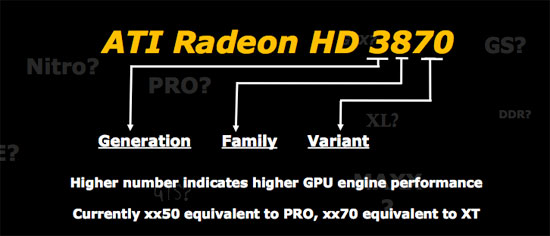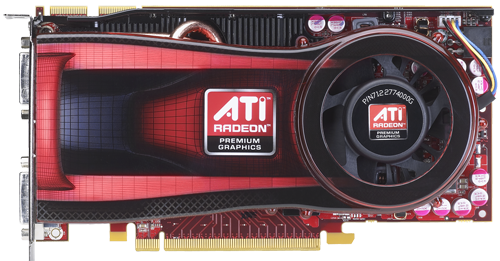Faster Graphics For Lower Prices: ATI Radeon HD 4770
by Derek Wilson on April 28, 2009 5:15 AM EST- Posted in
- GPUs
First things first: the Radeon HD 4770 is faster than existing 4800 series hardware (namely the 4830). Yes, this is by design.
We hate to start another article complaining about naming (there seems to be some sort of pervasive renaissance of poor naming this year), but let's talk about why exactly we are in this situation with a look back at something from our RV670 coverage:

At least it's ironic.
Yes, the problem is born out of AMD's attempt at sensible, appropriate naming. The problem is that AMD seems to want to associate that "family" number with the physical GPU than with the a performance class. This is despite the fact that they generally use increasing numbers for "families" that are generally faster. Thus, the 40nm RV740 needs a new family name, and they can't really choose 49xx presumably (by us) because people would be more upset if they saw a high number and got lower performance than if they saw a lower number and got higher performance. So Radeon HD 4770 it is.

When we brought up our issues with the naming scheme, AMD was quick to respond that naming is one of the most contentious things that go on in bringing a graphics card to market. People get passionate about the issue. Passion is great, but not if it confuses, misleads, or distracts the end user. And that's what a decision like this does. There is no practical reason that this card shouldn't be named 4840 to reflect where it's performance falls. After all, the recently released 4890 is host to quite a few tweaks to the physical layout of the chip and it isn't called the 4970.
At the same time, that trailing zero is doing nothing on all AMD hardware. There is an extra number in there that could allow AMD to shift some things around in their naming scheme to retain all the information they want to reflect about architecture generation, processes revision, performance class and specific performance within that class. If we are going to have a model number system, in order to have real value to both the informed and casual graphics card user it needs to be built to properly represent the underlying hardware AND be strictly related to performance. With this move, AMD joins NVIDIA in taking too many liberties with naming to the detriment of the end user.
Now that that's taken care of, what we have today is a 40nm GPU (the first) paired with 512MB of RAM on a $110 card. The package delivers performance at a level between the 4830 and the 4850. First indications were that this would be a $99 part and the performance we see with this card at the "magic" price would be terrific. It's still not bad at a 10% higher price. AMD had indicated that there should be some $10 mail in rebates available for those who are interested in the extra bonus hassle and upfront cost to get the cash.










88 Comments
View All Comments
JPForums - Tuesday, April 28, 2009 - link
I second the naming bashing. You spent a lot of time bashing a naming system that makes things short and simple. Frankly it makes a lot more sense than the previous standard of stringing along an ever increasing number of words.You would never expect a 43xx series card to beat a 38xx series card. Even though it has a higher number, it simply isn't going to happen. However, it is ludicrous to expect ATI to keep numbering their low end cards in the 3xxxs until the low end performance can match the highest end 3xxx cards performance. Even if they did, given the different architectures, you just complain that what they deem better doesn't match up with what you do. Further, it would quickly get very confusing trying to pick out the new cards from the old.
Categorizing the cards by architecture, then performance, makes much more sense than categorizing them by performance alone. This automatically distinguishes newer cards from older ones. This also tells you a little about where the card might be strong/weak and what you stand to gain by overclocking. (A card with twice the hardware will gain much more per MHz overclock than the already higher clock one with half the hardware assuming similar architecture)
That all said, there are some things ATI could do to make the current scheme better. I.E. Delegate x2xx, x5xx, and x8xx as the low, medium, and high end (Assuming 3 basic architectures are used). Then use x3xx, x6xx, and x9xx for the same purpose on the refresh.
Hopefully ATI can refine their naming scheme to address both architecture and performance considerations equally as you wish. However, to say that the current naming scheme is in the same class as GeForce GTX260 Core 216 is going overboard. Until they get a scheme that can address both considerations equally, I'd prefer the current architecture based distinctions over a simple performance only scheme.
Oh, and did you really that much time complaining about a such a minor issue. Address the issue, then move on to something more interesting like overclocking.
Alternately, address other naming scheme issues in equal length. nVidia's GeForce GTX260 Core 216 comes to mind. How about the GeForce 9800GTX that was slower than the 8800GTX. Or maybe the 9800GT that was slower than the 8800GTS. I always hate having to explain to people what the difference between my GTX260 Core 216 and the regular GTX260 is (especially when they don't remember the next time around). Also, try explaining to an average Joe that the second highest end of the current generation (at the time) is slower than the second highest end of the previous generation.
Personally, I wouldn't even put it in a review, but rather, I'd send my concerns directly to the company and let them work it out. If that didn't work, I'd put it in a rant not a review.
Seramics - Thursday, April 30, 2009 - link
very well said... i juz duno why this article spent so much time criticizing the 4770 name which i tink is completely fine. Whts wrong wif a 70 series of a 700 family outperforming a 30 series in the 800 family in the same 4000 generation? It is completely inadequate to base naming on purely performance aspect alone as the reasons mentioned above. If anything, they would be better off starting a flaming articles about nvidia naming scheme which is very very deceiving... how about G92 designated as GTX 280M i nthe mobile sector? Not to mention GTS250 being a renamed 9800GTX+. The + is a weird symbol in the naming in the first place. For generations its been jus suffixes n now theres a "+" sign. Why isnt there a "-" sign then for lower end product? How about 8800GS being a 8800GT-? Sounds good? And wht about GTX260 Core 216? WHy not GTX280 core 240? GTS250 core 128? So confusing n no standardization. Nvidia naming is all the place, nonsensical. It doesnt even sound good.RagingDragon - Wednesday, May 13, 2009 - link
I wish Nvidia had named the GTX260 respin GTX270 instead of "GTX260 Core 216". And I agree that the mobile names are downright deceptive.But a new 4770 (slightly) outperforming an end of life 4830 doesn't really bother me. I could see it being a bit annoying if the 4830 wasn't phased out, but as it is the naming complaint is trivial and petty - not worth wasting so much space in a review. Besides if AMD did call it 4840 instead of 4770 many people (though perhaps not AT) would accuse AMD of deceptively passing off the cheaper RV740 as an RV770. Furthermore, it's probably possible to concoct benchmarks which "prove" the 4830 (with sligly more memory bandwidth) is faster than the 4770.
Besides, I always thought the second digit in the AMD naming scheme to represent the GPU architechure - while increasing numbers would indicate faster architectures, the mid and high end RV770 cards (4850 and 4870) are faster than any 47xx card. In this case to top of the 47xx line overlaped the bottom of the 48xx - a problem AMD are sensibly correcting by dropping the more expensive to manufacture 4830...
Zoomer - Tuesday, April 28, 2009 - link
I think the name makes sense and is completely reasonable. IMO, ATi should not attempt to change something that works.It's far better than the nVidia fiasco. Imagine a 4500Pro XT+ that is nothing more than a rebranded 2900XT.
Or a Radeon 4000 MX 400 that is based off the GF2 MX, erm, I mean Radeon 32MB DDR.
Seramics - Thursday, April 30, 2009 - link
true...nvidia naming schemes is despicablebogda - Tuesday, April 28, 2009 - link
I agree completely. "Naming issue" is one of the most pointless pieces of writing on anandtech ever.crimson117 - Tuesday, April 28, 2009 - link
I find it very useful.Although the current state sure beats the terminally meaningless "GT, GS, GTS, GTX, GTX-S, GT+, GTX+" naming scheme.
It's a battle between graphics vendors priorities...
They have to choose between:
- Being accurate for informed users (the type who read anandtech)
- Marketing poorly performing, high-margin/high-volume cards to uninformed users
This is even more evident with their mobile parts. Why the hell would you (nVidia) call something a Mobile 9800M GT if it only performs like a desktop 9600GT? Why not call it a "mobile 9600 GT" so people know at a glance it's got 9600 GT performance with laptop-friendly power consumption? Is it really considered more important to communicate that it falls in the same relative position to other nVidia mobile parts as the 9800 falls into among other desktop parts?
RagingDragon - Wednesday, May 13, 2009 - link
++Nvidia's mobile GPU naming really annoys me.
flipmode - Tuesday, April 28, 2009 - link
I find the writing on this issue to be highly valuable. Why should the naming not make sense, be understandable, and do a good job of conveying relative performance? Why is a 47xx faster than a 48xx? Why would you ever complain about the author "going to bat" for the consumer for sensible product naming? The author is trying to help you and me!ssj4Gogeta - Tuesday, April 28, 2009 - link
I too find it useful. Companies like Nvidia will always try to deceive the customers. (8800->9800->9800+ ->GTS250)